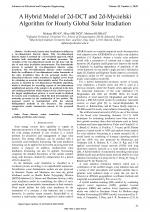| 2/2020 - 6 |
A Hybrid Model of 2d-DCT and 2d-Mycielski Algorithm for Hourly Global Solar IrradiationFIDAN, M. |
| Extra paper information in |
| Click to see author's profile in |
| Download PDF |
Author keywords
discrete cosine transform, forecasting, modeling, prediction, solar energy
References keywords
solar(34), energy(28), radiation(24), forecasting(15), hourly(14), global(13), renewable(12), model(11), neural(10), management(8)
Blue keywords are present in both the references section and the paper title.
About this article
Date of Publication: 2020-05-31
Volume 20, Issue 2, Year 2020, On page(s): 45 - 54
ISSN: 1582-7445, e-ISSN: 1844-7600
Digital Object Identifier: 10.4316/AECE.2020.02006
Web of Science Accession Number: 000537943500006
SCOPUS ID: 85087447882
Abstract
In this work, hourly solar irradiation is defined as a two-dimensional discrete signal. This two-dimensional discrete signal is modeled by a novel hybrid approach, which includes both deterministic and stochastic processes. The variables of the two-dimensional model are the hour and the day of each solar irradiation measurement. The deterministic process is modeled by two-dimensional discrete cosine transform. The two-dimensional discrete cosine transform finds the coefficients of two-dimensional cosine harmonics of the solar irradiation data. In the proposed model, two-dimensional discrete cosine transform is applied at two levels for obtaining an accurate deterministic model. The stochastic process is modeled by two-dimensional Mycielski algorithm, which is developed for searching repeats of two-dimensional neighborhood pattern of the sample to be predicted in the data and making predictions which depend on the closest repeat of the largest neighborhood pattern. A novel model is obtained for hourly solar irradiation, which fits both deterministic and stochastic processes by the combination of two models. The proposed model is benchmarked with the selected distinguished methods in the literature. The obtained comparative results demonstrate success of the proposed model. |
| References | | | Cited By |
Web of Science® Times Cited: 0
View record in Web of Science® [View]
View Related Records® [View]
Updated today
SCOPUS® Times Cited: 0
View record in SCOPUS® [Free preview]
There are no citing papers in the CrossRef Cited-by Linking system.
Disclaimer: All information displayed above was retrieved by using remote connections to respective databases. For the best user experience, we update all data by using background processes, and use caches in order to reduce the load on the servers we retrieve the information from. As we have no control on the availability of the database servers and sometimes the Internet connectivity may be affected, we do not guarantee the information is correct or complete. For the most accurate data, please always consult the database sites directly. Some external links require authentication or an institutional subscription.
Web of Science® is a registered trademark of Clarivate Analytics, Scopus® is a registered trademark of Elsevier B.V., other product names, company names, brand names, trademarks and logos are the property of their respective owners.
Faculty of Electrical Engineering and Computer Science
Stefan cel Mare University of Suceava, Romania
All rights reserved: Advances in Electrical and Computer Engineering is a registered trademark of the Stefan cel Mare University of Suceava. No part of this publication may be reproduced, stored in a retrieval system, photocopied, recorded or archived, without the written permission from the Editor. When authors submit their papers for publication, they agree that the copyright for their article be transferred to the Faculty of Electrical Engineering and Computer Science, Stefan cel Mare University of Suceava, Romania, if and only if the articles are accepted for publication. The copyright covers the exclusive rights to reproduce and distribute the article, including reprints and translations.
Permission for other use: The copyright owner's consent does not extend to copying for general distribution, for promotion, for creating new works, or for resale. Specific written permission must be obtained from the Editor for such copying. Direct linking to files hosted on this website is strictly prohibited.
Disclaimer: Whilst every effort is made by the publishers and editorial board to see that no inaccurate or misleading data, opinions or statements appear in this journal, they wish to make it clear that all information and opinions formulated in the articles, as well as linguistic accuracy, are the sole responsibility of the author.



